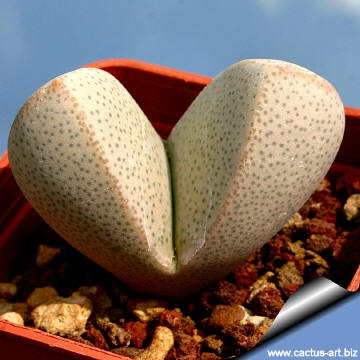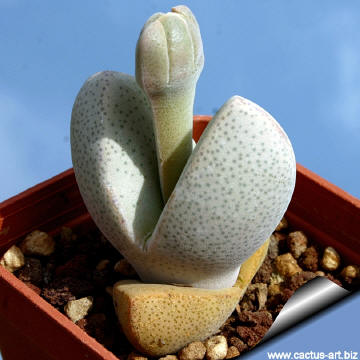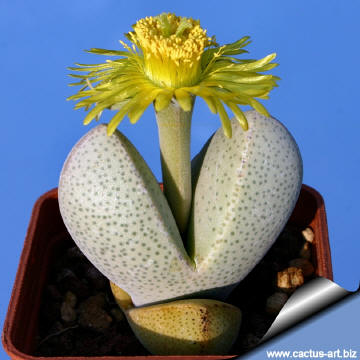-
x
Descrizione


|
Il Dinteranthus microspermus è una piccola succulenta acaule che cresce sopra terra. Lentamente con il tempo forma piccoli gruppi alti 2-3 cm con 3-7 teste, ognuna delle quali con solo due foglie nello stato di riposo vegetativo. Family: Mesebrianthemaceae (Aizoaceae) Origin: Namibia, Namaqualand, Northern cape, South Africa. (the ssp. 'puberulus' is geografically separated and occurs south east of the area of D. microspermus in the Kenhardt district) Habitat: Grows in quartz slopes, in summer raining areas. They both in colour and shape, resemble the stones and pebbles found in their natural habitat. The form and colour of the Dinteranthus have developed in order to allow them to live in the harsh conditions of their natural environment where they are able to stand extended periods of drought. Conservation status: Listed in CITES appendix 2. Common English Names include:
Etymology: The genus has been named after K. Dinter 1868-1945, German Government botanist working in Namibia 1897-1935.
|
|
|
Description: Dinteranthus microspermus is a small stemless succulent that grows above ground and not markedly buried after the manner of D. vanzylii. It is usually solitary or few branched, but subspecies 'puberulus' forms small compact groups with 3-7 branches up 2 to 3 cm high, each with a single leaf-pair in the resting state. |
|
|
Cultivation: Dinteranthus are summer growing species with dry rest period over winter but they do not shows an apparent dormant season like Lithops. Easy to grow they need a very open mineral, fast draining mix with little compost and a high degree of grit, coarse sand, small lava gravel or pebbles. Give them the maximum amount of light you are able to give them, but care should be taken about exposing them to the full blast of the sun rays in summer (The only exception to this is seedlings in their first year that enjoy a shades place) . Such tiny plants can easily get scorched or broiled and their appearance spoiled (this may not matter in the wild, where the Dinteranthus have probably shrunk into the ground and becomes covered with sands). Remarks: The strange appearance of Dinteranthus have made them very popular in succulent collections. They are similar in habit to Lithops but grows above ground (only D. vanzily is partly subterranean like Lithops with the top of each leaf tip exposed above soil). They are also called mimicry plants as they show a striking similarity to their background rocks and are difficult to detect when not in flower. The Dinteranthus have a pebbly look and are commonly known as pebble plants or living stones; each species is associated with one particular type of rock formation and occurs nowhere else. This camouflage also reduces the need for chemical defences against herbivores. |
|






